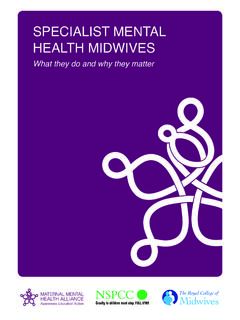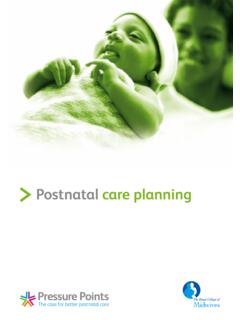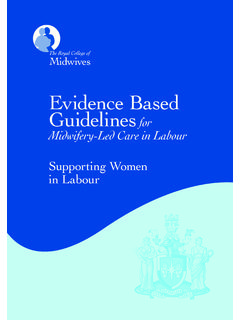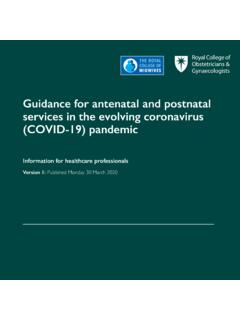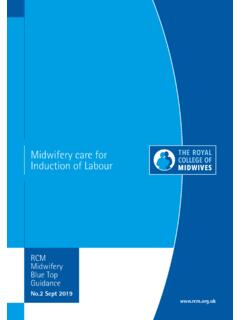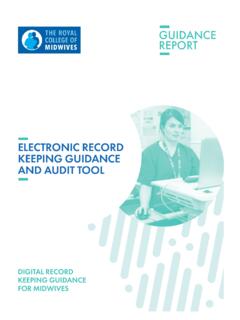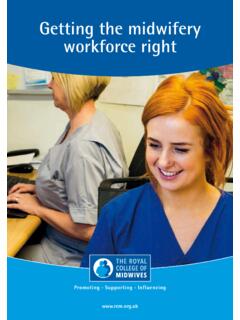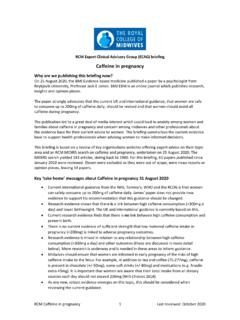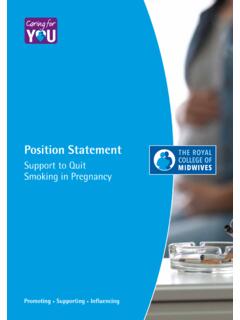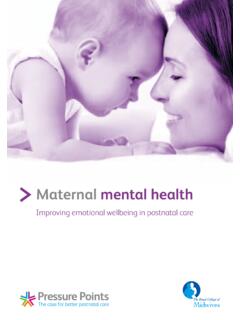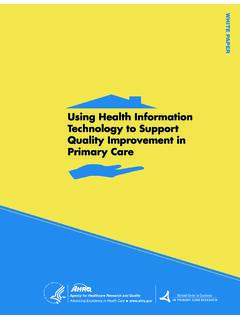Transcription of High Quality Midwifery Care - RCM
1 high QualityMidwifery Care23 high Quality Midwifery CareHigh Quality Midwifery CareForewordDelivering high Quality maternity care is the responsibility of every midwife. We all need to be activists determined to take both small and big steps to directly or indirectly improve care . This paper is written primarily for midwives and particularly for members of the is particularly pertinent for midwives employed within the NHS but may have resonance for midwives working in other situations. It will also be of interest to RCM members who work in supporting roles to midwives. The paper sets out the RCM s ideals in relation to four key areas so that you know what the RCM stands for. It gives you the evidence underpinning our stance. It identifies the challenges faced in achieving our ideals and finally suggests actions that the RCM thinks need to be taken if we are to overcome these all these actions can be taken by individuals and not all actions will be equally important in different workplaces.
2 Some will only be achieved through influencing and questioning others. We hope that members will use this document in their branches and networks, decide what they want to see change and seek RCM input into local discussions as to what can be done to achieve that The Royal College of Midwives defines and champions high Quality Midwifery , and is a major driver of high Quality maternity services. Our values and standards are strongly reflected in policy and practice throughout the UK, and are influential overseas. Our 42,700 members continue to lead, deliver and influence maternity awareness of the significant current changes in maternity services, and their influence on Midwifery and midwives, prompted this paper. The impact of major health service reforms, financial constraints and demands for greater efficiency, whilst at the same time improving Quality safety and women s experience, is felt in every maternity unit. So we all need to be clear about our vision of Midwifery , and what needs to happen to achieve good news is that although Midwifery policy and practice vary between the four UK countries, services and individual midwives, there is a UK-wide, indeed global consensus on many important maternity care issues (see opposite page).
3 The status of Midwifery in the UK is the envy of many countries. We deliver generally excellent services, but there is more to do to achieve safe, high Quality , individualised care for every woman, every time. Diversity is welcome, but unacceptable variation in standards and outcomes is not. Our challenge is to determine how best we can provide high Quality care now and in the future. What service models and structures should we use, what should our workforce look like, how will midwives be trained and developed, and how can our workplaces create cultures where high Quality is achieved? What follows is a discussion of our values, Quality and safety, followed by a summary of four key themes: service delivery, workforce, education and professional development, and workplace culture. Under each theme we set out our ideal, some key evidence, the challenges and actions to take. If every midwife takes action - working in co-operation with colleagues in maternity services and education - we can together deliver even better maternity care , and face the future with confidence and optimism.
4 5 high Quality Midwifery CareMidwifery at the heart of maternity servicesThe UK s NHS Midwifery -based maternity service usually achieves good outcomes. The midwife is central to high Quality maternity care , and the principle that all women need a midwife and some need a doctor too is widely accepted. The internationally agreed definition (1) recognises the midwife as a responsible and accountable professional who works in partnership with women to: give the necessary support, care and advice during pregnancy, labour and the postpartum period; conduct births on the midwife s own responsibility; provide care for the newborn and the infant, including preventive measures, the promotion of normal birth, the detection of complications in mother and child, the accessing of medical care or other appropriate assistance, and the carrying out of emergency measures. UK legislation from the 1902 Midwives Act onwards protects the public, promotes high Quality care through standards for practice and education, and enshrines the profession s purpose and has been broad consensus on how to achieve high Quality maternity services since the landmark 1993 Changing Childbirth report (2).
5 All four UK countries have policies that aim to promote woman-centred care , continuity of care , greater choice of place and type of birth, reduce unnecessary interventions, reduce inequalities and improve safety. Recent policy on early years also underlines the importance of high Quality maternity services (3). Around 26,500 whole-time equivalent midwives work in the NHS. In England 1700 additional midwives have been employed since the general election in 2010, and numbers are stable in the other countries. Midwifery student places have been explicitly protected in England. As a respected professional association, the RCM is always consulted, never ignored, and our policies endorsed by key organisations. 6 Values, Quality and safetyA healthy mother and a healthy baby and family integrity must be the focus of high Quality maternity services. high Quality care should be safe, effective, woman-centred, timely and equitable. It should also be evidence-based and delivered as close as possible to the communities where women live or work.
6 It should continue to be free and accessible to everyone at the point of Quality care encompasses Midwifery -led care for normal pregnancy, birth and the postnatal period. All women need Midwifery care at every stage. The midwife helps women make decisions based on their clinical need, values and preferences, on the research evidence and on the context of care . In both the short term and the long term, pregnancy and early years have a decisive impact on the health and well-being of mothers, children and families (page 8). The midwife thus has a vital part to play not only in helping to ensure the health of mother and baby, but in their future health and well-being and that of society as a vision is derived from shared values, experiences and evidence. It resonates with the NHS Constitution in England (4) and similar principles enshrined in legislation and policy in Scotland, Wales and Northern Ireland. The core values of the NHS include respect; compassion; commitment to Quality of care ; and working together for patients.
7 The Quality and effectiveness of Midwifery -led care is highlighted in robust evidence from the UK and overseas (5). Major studies help to shape maternity policy, for example on the advantages of Midwifery -led settings (6) and Midwifery -led continuity of care (7).Evidence-based standards, guidelines and consensus statements for maternity care form the basis of Midwifery practice, produced by authorities like the National Institute for Health and Clinical Excellence (8, 9 and 10), the Royal College of Obstetricians and Gynaecologists (11) and of course the RCM. Midwives usually deliver safe services that contribute to the UK s improving maternal and neonatal mortality rates. Most women are satisfied with their care and outcomes are good. There are many examples of excellent practice. However we could do even better. Not all women are truly at the centre of their care , some are denied their choices, and some want more and better 7 high Quality Midwifery Careinteraction with midwives (12).
8 The RCM s own Pressure Points Campaign highlights that there are significant problems in the provision of high Quality postnatal care . is important because when care doesn t go well there are high human and financial costs. Problems usually result from a combination of failures in a health system, rather than the isolated actions or omissions of a single professional. The underlying causes may be related to limited choice being available in reality and lack of women s involvement in decision-making; unnecessary medical interventions; staff shortages and poor training; lack of capacity; poor skill mix; and organisational structures and cultures that do not support best practice (13). Whilst more research is needed to develop our understanding of care that delivers the best outcomes, the existing evidence is strong. However the implications of existing evidence, and the guidelines and standards based on it, are not always known or heeded, particularly as they relate to normal enshrined in maternity policy do not always translate into practice.
9 For example choice of provider, choice of location and choice of type of maternity care are advocated but what choice for women means in reality is different across and within countries, regions and localities (14). By law every woman has the right to refuse medical treatment and must give informed consent for treatment, except in a small number of cases where women lack mental capacity. All the options must be fully discussed with every woman, her choices must be respected, and her human rights always upheld. Maternity teams, starting from a holistic perspective that encompasses emotional, psychological and social as well as physical needs, should reach explicit agreement on how they can empower women to make their own personal choices about how they plan their pregnancy, birth and postnatal care . It takes time to realise the benefits of a new Midwifery -led unit, or to improve long-term outcomes for children. It is important to invest for the longer term, and invest to save.
10 These complex, interacting issues inform the four key themes of this paper. If you wish to explore the evidence further you can check the references, and the wealth of information on the RCM website. 8 The long-term impact of pregnancy and early yearsPregnancy and early life lay the foundations for our individual health, well-being, cognitive development and emotional security - not just in childhood but also in adult life (15). What happens to children before they are born and in their early years profoundly affects their future health and wellbeing. The evidence is well documented on what is important in maternity care and the opportunities for improving health and wellbeing, for example in the Marmot Review (16). We know that the health of mothers is critical to the development of their children both before and after birth. Their nutritional status before and during pregnancy, their mental health and their lifestyle choices are all to improve a child s health and life chances are needed from the very beginning of life.
